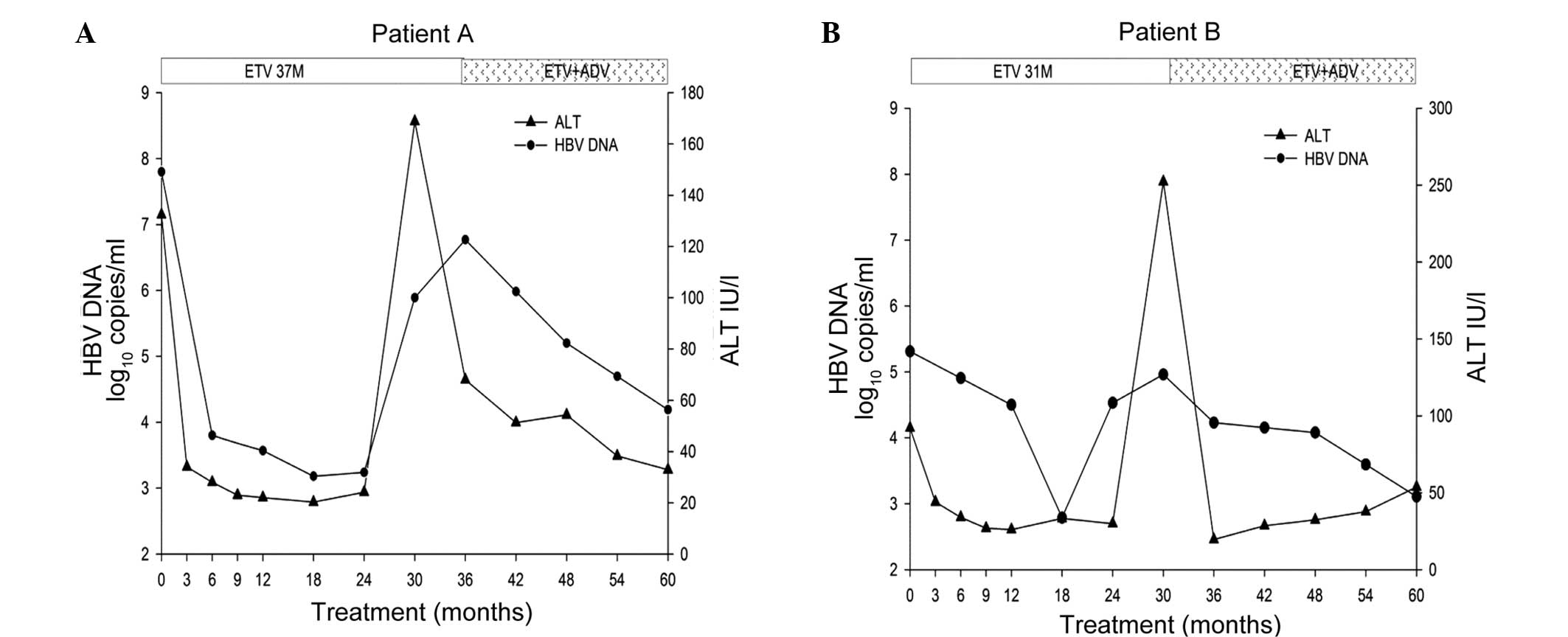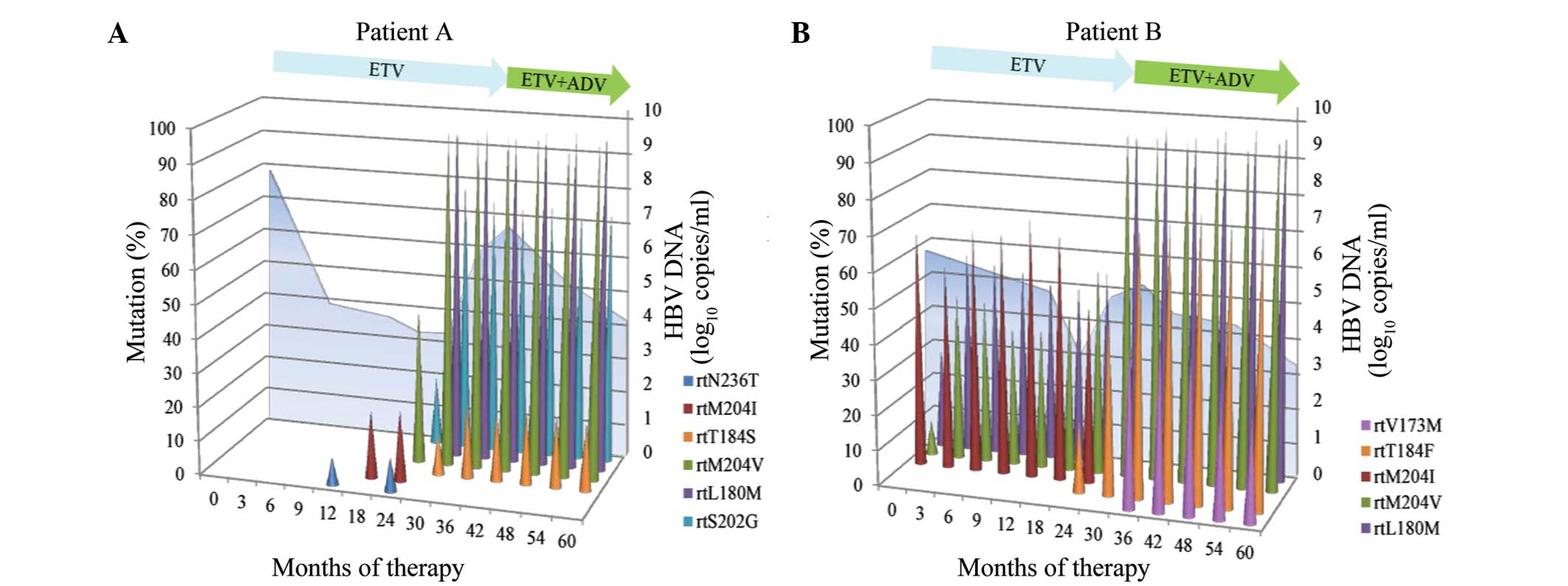|
1
|
Peng CY, Chien RN and Liaw YF: Hepatitis B
virus-related decompensated liver cirrhosis: benefits of antiviral
therapy. J Hepatol. 57:442–450. 2012. View Article : Google Scholar : PubMed/NCBI
|
|
2
|
Liaw YF and Chu CM: Hepatitis B virus
infection. Lancet. 373:582–592. 2009. View Article : Google Scholar : PubMed/NCBI
|
|
3
|
Buti M: HBeAg-positive chronic hepatitis
B: Why do I treat my patients with Nucleos(t)ide analogs? Liver
Int. 34(Suppl 1): 108–111. 2014. View Article : Google Scholar : PubMed/NCBI
|
|
4
|
Viganò M, Mangia G and Lampertico P:
HBeAg-negative chronic hepatitis B: Why do I treat my my patients
with nucleos(t)ide analogs? Liver Int. 34(Suppl 1): 120–126. 2014.
View Article : Google Scholar : PubMed/NCBI
|
|
5
|
Dienstag JL, Goldin RD, Heathcote EJ, et
al: Histological outcome during long-term lamivudine therapy.
Gastroenterology. 124:105–117. 2003. View Article : Google Scholar : PubMed/NCBI
|
|
6
|
Zoulim F and Locarnini S: Hepatitis B
virus resistance to nucleos(t)ide analogues. Gastroenterology.
137:1593–1608, e1-e2. 2009. View Article : Google Scholar : PubMed/NCBI
|
|
7
|
Lok AS and McMahon BJ: Chronic hepatitis
B: update 2009. Hepatology. 50:661–662. 2009. View Article : Google Scholar : PubMed/NCBI
|
|
8
|
European Association For The Study of The
Liver: EASL clinical practice guidelines: Management of chronic
hepatitis B virus infection. J Hepatol. 57:167–185. 2012.
View Article : Google Scholar : PubMed/NCBI
|
|
9
|
Liaw YF, Kao JH, Piratvisuth, et al:
Asian-Pacific consensus statement on the management of chronic
hepatitis B: A 2012 update. Hepatol Int. 6:531–561. 2012.
View Article : Google Scholar : PubMed/NCBI
|
|
10
|
Lok AS, Zoulim F, Locarnini S, et al:
Antiviral drug-resistant HBV: standardization of nomenclature and
assays and recommendations for management. Hepatology. 46:254–265.
2007. View Article : Google Scholar : PubMed/NCBI
|
|
11
|
Kobashi H, Fujioka S, Kawaguchi M, et al:
Two cases of development of entecavir resistance during entecavir
treatment for nucleoside-naive chronic hepatitis B. Hepatol Int.
3:403–410. 2009. View Article : Google Scholar : PubMed/NCBI
|
|
12
|
Tenney DJ, Rose RE, Baldick CJ, et al:
Long-term monitoring shows hepatitis B virus resistance to
entecavir in nucleoside-naive patients is rare through 5 years of
therapy. Hepatology. 49:1503–1514. 2009. View Article : Google Scholar : PubMed/NCBI
|
|
13
|
Tenney DJ, Levine SM, Rose RE, et al:
Clinical emergence of entecavir-resistant hepatitis B virus
requires additional substitutions in virus already resistant to
Lamivudine. Antimicrob Agents Chemother. 48:3498–3507. 2004.
View Article : Google Scholar : PubMed/NCBI
|
|
14
|
Villet S, Ollivet A, Pichoud C, et al:
Stepwise process for the development of entecavir resistance in a
chronic hepatitis B virus infected patient. J Hepatol. 46:531–538.
2007. View Article : Google Scholar : PubMed/NCBI
|
|
15
|
Lee HW, Kim HJ, Hong SP, et al:
Simultaneous emergence of entecavir resistance mutations in a
nucleoside-naive chronic hepatitis B patient. Intervirology.
55:380–384. 2012. View Article : Google Scholar : PubMed/NCBI
|
|
16
|
Lee GH, Inoue M, Toh JK, et al: Two-step
evolution of the hepatitis B drug-resistant mutations in a patient
who developed primary entecavir resistance. Liver Int. 33:642–646.
2013. View Article : Google Scholar : PubMed/NCBI
|
|
17
|
Tenney DJ, Rose RE, Baldick CJ, et al:
Two-year assessment of entecavir resistance in
Lamivudine-refractory hepatitis B virus patients reveals different
clinical outcomes depending on the resistance substitutions
present. Antimicrob Agents Chemother. 51:902–911. 2007. View Article : Google Scholar : PubMed/NCBI
|
|
18
|
Ko SY, Kim BK, Kwon SY, et al: Clonal
evolution of hepatitis B virus polymerase gene mutations during
lamivudine-adefovir combination treatment. World J Gastroenterol.
18:6437–6446. 2012. View Article : Google Scholar : PubMed/NCBI
|
|
19
|
Degertekin B and Lok AS: Monitoring
antiviral resistance in patients receiving nucleos(t)ide analog
therapies for hepatitis B: which method should be used? J Hepatol.
48:892–894. 2008. View Article : Google Scholar : PubMed/NCBI
|
|
20
|
Lindström A, Odeberg J and Albert J:
Pyrosequencing for detection of lamivudine-resistant hepatitis B
virus. J Clin Microbiol. 42:4788–4795. 2004. View Article : Google Scholar : PubMed/NCBI
|
|
21
|
Goodman ZD: Grading and staging systems
for inflammation and fibrosis in chronic liver diseases. J Hepatol.
47:598–607. 2007. View Article : Google Scholar : PubMed/NCBI
|
|
22
|
Pallier C, Castéra L, Soulier A, et al:
Dynamics of hepatitis B virus resistance to lamivudine. J Virol.
80:643–653. 2006. View Article : Google Scholar : PubMed/NCBI
|
|
23
|
Pallier C, Rodriguez C, Brillet R,
Nordmann P, Hézode C and Pawlotsky JM: Complex dynamics of
hepatitis B virus resistance to adefovir. Hepatology. 49:50–59.
2009. View Article : Google Scholar : PubMed/NCBI
|
|
24
|
Chayama K, Suzuki Y, Kobayashi M, et al:
Emergence and takeover of YMDD motif mutant hepatitis B virus
during long-term lamivudine therapy and re-takeover by wild type
after cessation of therapy. Hepatology. 27:1711–1716. 1998.
View Article : Google Scholar : PubMed/NCBI
|
|
25
|
Deng XL, Li QL and Guo JJ: Dynamics of
lamivudine-resistant hepatitis B virus strains in patients with
entecavir rescue therapy. Virus Genes. 47:1–9. 2013. View Article : Google Scholar : PubMed/NCBI
|
|
26
|
Guo JJ, Li QL, Shi XF, et al: Dynamics of
hepatitis B virus resistance to entecavir in a
nucleoside/nucleotide-naive patient. Antiviral Res. 81:180–183.
2009. View Article : Google Scholar : PubMed/NCBI
|
|
27
|
Lee JH, Cho Y, Lee DH, et al: Prior
exposure to lamivudine increases entecavir resistance risk in
chronic hepatitis B Patients without detectable lamivudine
resistance. Antimicrob Agents Chemother. 58:1730–1737. 2014.
View Article : Google Scholar : PubMed/NCBI
|
|
28
|
Ono A, Suzuki F, Kawamura Y, et al:
Long-term continuous entecavir therapy in nucleos(t)ide-naïve
chronic hepatitis B patients. J Hepatol. 57:508–514. 2012.
View Article : Google Scholar : PubMed/NCBI
|
|
29
|
Zhao P, Wang C, Huang L, Xu D and Li T:
Comparison of rescue strategies in lamivudine-resistant patients
with chronic hepatitis B. Antiviral Res. 96:100–104. 2012.
View Article : Google Scholar : PubMed/NCBI
|
|
30
|
Sherman M, Yurdaydin C, Simsek H, et al:
Entecavir therapy for lamivudine-refractory chronic hepatitis B:
Improved virologic, biochemical and serology outcomes through 96
weeks. Hepatology. 48:99–108. 2008. View Article : Google Scholar : PubMed/NCBI
|
|
31
|
Colonno RJ, Rose R, Baldick CJ, et al:
Entecavir resistance is rare in nucleoside naive patients with
hepatitis B. Hepatology. 44:1656–1665. 2006. View Article : Google Scholar : PubMed/NCBI
|
|
32
|
Yim HJ, Hussain M, Liu Y, Wong SN, Fung SK
and Lok AS: Evolution of multi-drug resistant hepatitis B virus
during sequential therapy. Hepatology. 44:703–712. 2006. View Article : Google Scholar : PubMed/NCBI
|
|
33
|
Zoulim F: Hepatitis B virus resistance to
entecavir in nucleoside naive patients: Does it exist? Hepatology.
44:1404–1407. 2006. View Article : Google Scholar : PubMed/NCBI
|
|
34
|
Ijaz S, Arnold C, Dervisevic S, et al:
Dynamics of lamivudine-resistant hepatitis B virus during adefovir
monotherapy versus lamivudine plus adefovir combination therapy. J
Med Virol. 80:1160–1170. 2008. View Article : Google Scholar : PubMed/NCBI
|
|
35
|
Villeneuve JP, Durantel D, Durantel S, et
al: Selection of a hepatitis B virus strain resistant to adefovir
in a liver transplantation patient. J Hepatol. 39:1085–1089. 2003.
View Article : Google Scholar : PubMed/NCBI
|
|
36
|
Chang TT, Liaw YF, Wu SS, et al: Long-term
entecavir therapy results in the reversal of fibrosis/cirrhosis and
continued histological improvement in patients with chronic
hepatitis B. Hepatology (Baltimore, Md.). 52:886–893. 2010.
View Article : Google Scholar : PubMed/NCBI
|
















